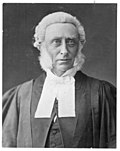Background
John Hall resigned as Premier due to health issues and a Cabinet conflict with Native Minister John Bryce, which led Governor Gordon to attempt to call Sir George Grey to form a Ministry. Hall reminded the Governor that his following held a majority in the House of Representatives and nominated Frederick Whitaker to replace him. [3] Whitaker had been the Hall Government's representative in the Legislative Council, renowned as "a Triton among minnows" in that house. [4] Harry Atkinson represented Whitaker in the lower house.
The Ministry succeeded Hall's retrenching government, but as a Budget surplus had been achieved, they felt able to reduce the property tax by half and raise a 3 million pound loan for Public Works. [5] Atkinson introduced a bill to establish a contributory social security scheme in 1882, but this was well ahead of contemporary opinion, and his second attempt in 1883 was greeted with "ribald laughter". [6] Similarly, William Rolleston’s attempt to create a perpetual Crown lease option for land ownership was amended beyond recognition by the Legislative Council. [7]
On 15 September 1882 the ministry passed the North Island Main Trunk Railway Loan Act, [8] to expedite construction of the North Island Main Trunk south of Te Awamutu by authorising the overseas borrowing of a million pounds for the work.
Whitaker had only intended to serve for a single session of Parliament, and having found the Premiership tiresome, he returned to his legal practice. [9] He was succeeded by his close colleague Harry Atkinson.
This page is based on this
Wikipedia article Text is available under the
CC BY-SA 4.0 license; additional terms may apply.
Images, videos and audio are available under their respective licenses.







